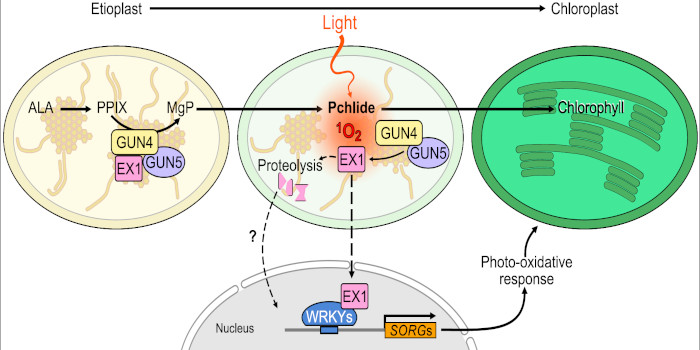How EXECUTER1 executes chloroplast-to-nucleus signaling in response to singlet oxygen
Background: In response to developmental and environmental cues such as changing light intensity, plastids/chloroplasts produce and emit signals such as singlet oxygen, 1O2. These signals broadly affect the expression of nuclear genes, thereby altering chloroplast function to help the plant develop and acclimate to the changing environment. This signaling process is termed retrograde signaling. The chloroplast-localized protein EXECUTER1 (EX1) is required for 1O2-triggered retrograde signaling.
Question: What are the biochemical properties of EX1 and how is 1O2-mediated retrograde signaling transduced from plastids to the nucleus?

Findings: Using a forward genetic screen in Arabidopsis thaliana, we identified GENOMES UNCOUPLED4 (GUN4) and GUN5 as two suppressors of a pif1 pif3 double mutant, which lacks the function of PHYTOCHROME-INTERACTING FACTOR1 (PIF1) and PIF3. GUN4 and GUN5 interacted with EX1 and its homolog EX2 in plastids, and 1O2 prevented this interaction. The gun4, gun5, ex1, and ex2 mutants showed increased tolerance of high light, whereas seedlings overexpressing GUN4 or EX1 were sensitive to photobleaching. Upon induction by 1O2, EX1 transiently accumulated and translocated from plastids to the nucleus and the nuclear targeting of EX1 was required for its function. In the nucleus, EX1 interacted with the transcription factors WRKY18 and WRKY40 and functioned as a transcriptional co-activator to promote the expression of 1O2-responsive genes. We propose a working model in which EX1 directly mediates retrograde 1O2 signaling from plastids to the nucleus.
Next steps: We are interested in how EX1 is spatially regulated in the retrograde 1O2 signaling pathway.
Reference:
Yuhong Li, Hanhong Liu, Tingting Ma, Jialong Li, Jiarui Yuan, Yong-Chao Xu, Ran Sun, Xinyu Zhang, Yanjun Jing, Ya-Long Guo, Rongcheng Lin (2023). Arabidopsis EXECUTER1 interacts with WRKY transcription factors to mediate plastid-to-nucleus singlet oxygen signaling. https://doi.org/10.1093/plcell/koac330



